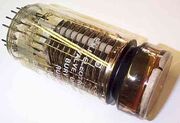Photomultiplier tubes (photomultipliers or PMTs for short), members of the class of vacuum tubes, and

Photomultiplier tube.
more specifically phototube|phototubes, are extremely sensitive detectors of light in the ultraviolet, visible light], and near-infrared ranges of the electromagnetic spectrum|electromagnetic spectrum. These detectors multiply the current produced by incident light by as much as 100000000 times (i.e., 160 decibel (dB)), in multiple dynode stages, enabling (for example) individual photons to be detected when the incident flux of light is very low.
The combination of high gain, low signal noise, high-frequency response, and large area of collection has earned photomultipliers an essential place in nuclear and particle physics, astronomy, medical diagnostics including blood tests, medical imaging, motion picture film scanning (telecine), and high-end image scanners known as drum scanners. Semiconductor devices, particularly avalanche photodiodes, are alternatives to photomultipliers; however, photomultipliers are uniquely well-suited for applications requiring low-noise, high-sensitivity detection of light that is imperfectly collimated light|collimated. While photomultipliers are extraordinarily sensitive and moderately efficient, research is still underway to create a photon-counting light detection device that's fully efficient. Such a detector is of interest for applications related to quantum information and quantum cryptography. Elements of photomultiplier technology, when integrated differently, are the basis of night vision devices.
Trivia[]
- Item was used by Leonard during his work with physicist David Underhill.
More Information[]
For further details and history, view Photomultiplier in Wikipedia.
